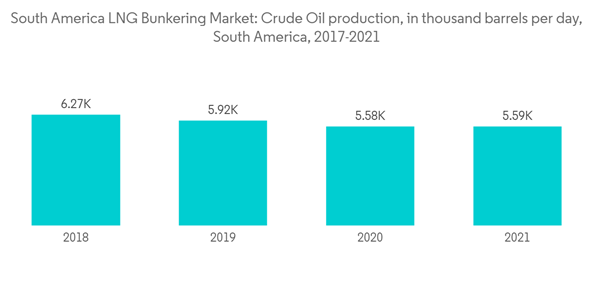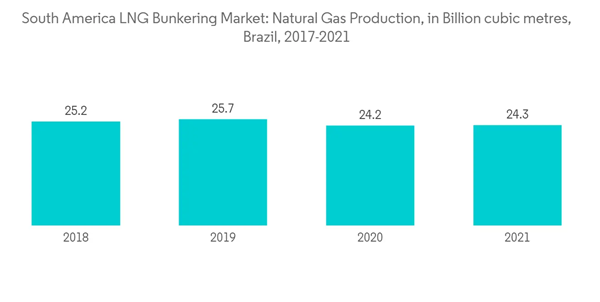The South America LNG bunkering market is expected to grow at a CAGR of more than 2% over the forecast period.
The market was negatively impacted by the COVID-19 pandemic, as demand for LNG bunkering services fell as marine shipping and trade declined significantly. However, the market has since rebounded and is expected to grow steadily during the forecast period.
This product will be delivered within 2 business days.
The market was negatively impacted by the COVID-19 pandemic, as demand for LNG bunkering services fell as marine shipping and trade declined significantly. However, the market has since rebounded and is expected to grow steadily during the forecast period.
Key Highlights
- Over the long term, factors such as rising investments in LNG bunkering infrastructure and facilities are expected to drive the market during the forecast period.
- On the flip side, the increasing adoption of alternative low-sulfur fuels such as Marine Gas Oil (MGO) and Low-Sulfur Fuel Oil (LSFO) is expected to restrain the market during the forecast period.
- Nevertheless, rising investments in small-scale LNG infrastructure are expected to provide a significant opportunity for the market beyond the forecast period.
South America LNG Bunkering Market Trends
Increase in Maritime Activities is Expected to Drive the Market
- The region is home to the Panama Canal and represents around 15% of the total number of trade services across the world, as the region is home to a few of the largest oil-producing nations, such as Brazil, Venezuela, and Argentina. The oil and gas activities, especially offshore E&P activities, are expected to increase further, driving maritime activities.
- Furthermore, the region falls right in line with the trading route of the United States and Asian countries. The region offers enormous potential for expanding LNG bunkering activities as it could become a trans-shipment hub to fuel consumers following the trade route in the Caribbean, Central, and South American regions.
- The region is also a hub for offshore oil and gas exploration and offshore wind. As of 2021, the region's cumulative crude oil production stood at nearly 5588 thousand barrels daily, declining over the past few years. To reverse the decline and cash in on oil reserves in a high-price environment, most countries in the region are investing heavily in the hydrocarbon E&P sector to produce more hydrocarbons and maximize oil revenues.
- Brazil has several large-scale offshore upstream projects in the pipeline, and it is expected to contribute more than 20% of global offshore crude oil and condensate production by 2025. The majority of the production is expected from the Pão de Açúcar in the Campos basin and Carcará fields.
- Similarly, in Argentina, In September 2021, the Argentina government sent a bill to Congress on Wednesday to promote hydrocarbon investment in a bid to increase domestic production in the vast Vaca Muerta shale formation and beyond, as well as to boost oil and gas exports.
- In December 2022, Argentina's state-backed energy company YPF and Malaysia's Petronas signed an MoU under which they announced a plan to build a USD 10 billion liquefaction terminal and related infrastructure.
- In Guyana, the offshore StabroekBlock is one of the most significant hydrocarbon discoveries in this decade, and in October 2021, ExxonMobil, the operator of the block, updated its estimate of the recoverable hydrocarbon resources to 10 billion oil-equivalent barrels.
- To leverage its hydrocarbon potential, Guyana has started the process of the development of the rest of its underdeveloped hydrocarbon value chain. GoInvest, a Guyana government agency, announced in October 2021 that the country was planning to build a 220 km-long subsea gas pipeline, which will have the capacity to transport about 50MMSCFD from ExxonMobil-operated Liza Phase 1 and 2 projects. The pipeline will also supply gas to a proposed gas-fired power plant, construction of which is expected to begin in 2022.
- Hence, rising investments in the offshore oil and gas sector are expected to drive the demand for LNG bunkering facilities for marine vessels, especially OSVs, and hence, significant investments in marine infrastructure are expected to drive the market during the forecast period.
Brazil to Witness Significant Growth in the Market
- In 2021, Brazil accounted for around 52% of the South American crude oil production. Moreover, in 2021, the country contributed around 16% to the region’s natural gas production in the same year. The country emerged as the largest producer of oil in the region, due to its increasing production volume.
- As of 2021, natural gas production in Brazil has reached 24.3 billion cubic meters and had a total proved natural gas resources of 12.3 trillion cubic meters. The presence of such large gas reserves, and growing international demand for LNG is expected to boost up the LNG bunkering market in the coming years.
- Hence, with the expected increase in oil and gas production, trading activities are expected to further increase between Brazil and the rest of the world. As gas production grows, Brazil is expected to increase LNG production, and subsequently, the market for LNG bunkering is expected to grow rapidly.
- For instance, in November 2022, Kanfer Shipping AS signed a partnership deal with Nimofast Brasil S.A. to establish small and medium-scale LNG shipping, small-scale floating storage units (FSU) and LNG bunkering solutions in Brazil from 2025 onwards. Such developments highlight the growing demand for LNG Thus, Brazil is expected to become an emerging market for LNG bunkering in the near future.
- The use of LNG as a marine fuel, following the International Maritime Organization (IMO) regulations, is witnessing constant increase across the world. However, the LNG bunkering activities in the South American region except Brazil have not picked up as compared to other regions.
South America LNG Bunkering Market Competitor Analysis
The South America LNG bunkering market is consolidated. Some of the key players in the market (in no particular order) include AES Corp, Engie SA, Kanfer Shipping AS, CB Fenton & Co., and Avenir LNG Ltd., among others.Additional benefits of purchasing the report:
- The market estimate (ME) sheet in Excel format
- 3 months of analyst support
This product will be delivered within 2 business days.
Table of Contents
1 INTRODUCTION
4 MARKET OVERVIEW
5 MARKET SEGMENTATION
6 COMPETITIVE LANDSCAPE
Companies Mentioned (Partial List)
A selection of companies mentioned in this report includes, but is not limited to:
- AES Corp
- Engie SA
- Avenir LNG Ltd
- Kanfer Shipping AS
- CB Fenton & Co.
- Minerva Bunkering
Methodology

LOADING...










